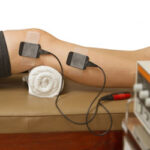Why Is Physical Therapy for Movement Disorders So Important?
At Neurology Solutions, we believe that every movement disorder patient can benefit from Physical Therapy (PT). Certain exercises have been proven to have a tremendous positive impact, helping movement disorder patients better manage their symptoms. PT belongs right up there with medications and procedures as a go-to tool for the treatment of movement disorders.
Many Objectives, But Just One Goal
There are many objectives we want to accomplish while treating movement disorder patients, such as improved balance, better coordination, and increased flexibility, endurance, and strength. But all of these objectives are in service of just one goal: to improve the patient’s quality of life, period.
The fact of the matter is that a movement disorder diagnosis is not something that can be treated with a pill or a single procedure — with movement disorders, there is no such thing as “set it and forget it.”
Successfully treating a movement disorder requires a comprehensive approach, and physical therapy is just one, essential part of that comprehensive approach. Without a rigorous PT regimen, the chances for a positive outcome for the patient are significantly diminished.
Physical Therapy Modalities We Use at
Neurology Solutions
Parkinson’s Disease Exercise

There have been many types of exercise that have been proven to improve function in the Parkinson’s population.
Parkinson’s Disease Exercise
Strain-Counterstrain

Purposefully non-traumatic, the Strain-Counterstrain technique reduces pain related to both neuromuscular and musculoskeletal disorders.
Strain-Counterstrain
Integrative Dry Needling

Integrative Dry needling (IDN) is a more modern technique utilized by physical therapists to help ease muscle strain due to injury. Despite the use of needles, IDN is different than acupuncture.
Integrative Dry Needling
Kinesiology Taping

Kinesiology taping is one specific mode of treatment that physical therapists may use that involves placing strips of special tape on your body in specific directions to help improve your mobility and/or support your joints, muscles, and tendons.
Kinesiology Taping
IASTM

Instrument-assisted soft tissue mobilization (IASTM) is applied using specially designed instruments to provide a mobilizing effect to soft tissue (e.g., scar tissue, myofascial adhesion) to decrease pain and improve range of motion (ROM) and function.
IASTM
Mulligan Technique (Mobilization with Movement)

Brian R. Mulligan founder of Mobilization with movement (MWM) technique created an application of sustained accessory mobilization applied by a therapist and an active physiological movement to end range applied by the patient.
Mulligan Technique (Mobilization with Movement)
McKenzie Method

Founded by Robin McKenzie, this technique was created to teach patients suffering from neck pain and/or back pain how to treat themselves and manage their own pain for life using exercise and other strategies.
McKenzie Method
Cupping

Cupping therapy has been utilized in many cultures for centuries with recent popularity in the professional athletic population and is now commonly used in physical therapy clinics.
Cupping
Functional Release Technique

Functional release technique is a soft tissue method that focuses on relieving tissue tension via the removal of fibrosis/adhesions which can develop in tissues as a result of overload due to repetitive use.
Functional Release Technique
Vestibular Rehabilitation

Vestibular rehabilitation is designed to reduce vertigo and dizziness, visual disturbance, and/or imbalance, and falls.
Vestibular Rehabilitation
E Stimulation Therapy (E-stim)

E-stim is a type of therapeutic treatment that can serve different purposes for physical therapy.
E Stimulation Therapy (E-stim)
Become a New Patient at Neurology Solutions
If you’d like to establish care at Neurology Solutions as a new patient, click the button.
Here you’ll find everything you need to know.











